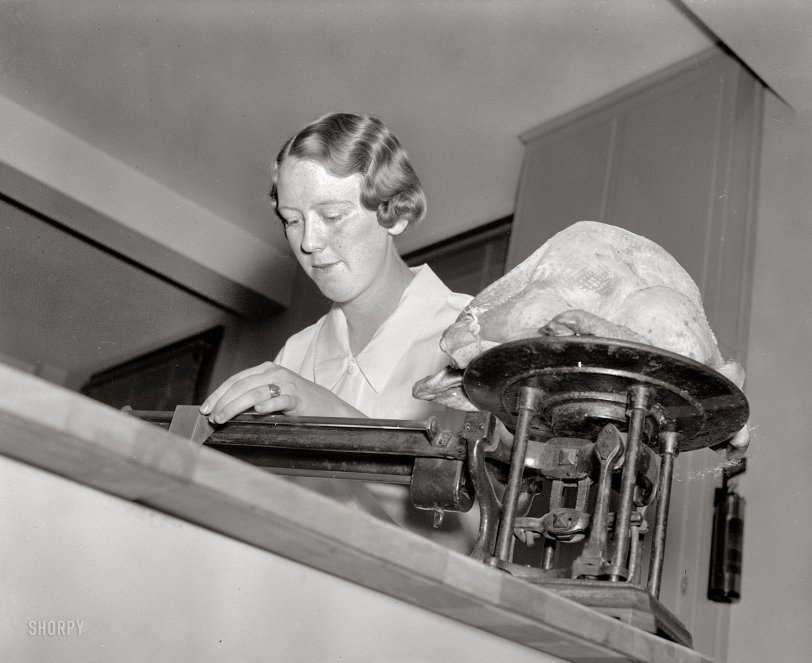


Framed or unframed, desk size to sofa size, printed by us in Arizona and Alabama since 2007. Explore now.
Shorpy is funded by you. Patreon contributors get an ad-free experience.
Learn more.

- Baldwin 62303
- Baldwin VO-1000
- Cold
- No expense spared
- Tough Guys
- Lost in Toyland
- And without gloves
- If I were a blindfolded time traveler
- Smoke Consumer Also Cooks
- Oh that stove!
- Possibly still there?
- What?!?
- $100 Reward
- Freeze Frame
- Texas Flyer wanted
- Just a Year Too Soon
- WWII -- Replacing men with women at the railroad crossing.
- Yes, Icing
- You kids drive me nuts!
- NOT An Easy Job
- I wonder
- Just add window boxes
- Icing Platform?
- Indiana Harbor Belt abides
- Freezing haze
- Corrections (for those who care)
- C&NW at Nelson
- Fallen Flags
- A dangerous job made worse
- Water Stop
Print Emporium
Jessie and Tom: 1937

December 4, 1937. Washington, D.C. "Miss Jessie Lamb demonstrates correct way to bake turkey. In this very scientific kitchen each bird is weighed before it goes into the oven as a difference in weight demands a change in cooking time." Happy Thanksgiving from Shorpy! Harris & Ewing glass negative. View full size.
Gobble gobble
Jessie, did you disinfect that modern scale? 21st century standards require you to at least wipe it down with a 50/50 clorox/water solution, but you probably already know that. Do you Jessie??
Tom Thumb
I suspect that these were the tests that produced the USDA's old "twenty minutes per pound" rule of thumb that, sadly, desiccated so many turkeys.
Help!
Jessie Lamb and Tom Turkey: there's a punch line in there somewhere but I'm too sated on tryptophan and pumpkin pie to make the connection.
Turkey Tedium
Washington Post, Nov 18, 1937U.S. Assigns 6 Testers to Eat Turkey All Day;
Sure, You Can get Tired of It They ConcludeMen have given their all to science, have staked their lives on experimental serums and undergone the bites of reptiles that antidotes might be found. And now, in another adventure of science, a group of volunteers in the Agriculture Department are eating turkey - eating turkey until turkey becomes tedious - with the threat of losing their waistlines. It is all for science.
For the first time in taste-testing history the group, three men and three women, sat yesterday at a board and started eating turkey. Before them was a luscious browned turkey, scientifically baked by the Bureau of Home Economics. Individually, each would nibble a slice of turkey, then purse the lips reflectively. discerningly, meditatively.
Then each would take a sip of coffee. a bite of cracker, a munch at an apple. Then another taste of turkey; and the eyes would look off, searching, again meditatively and discerningly. A notation would be made on a score sheet. This score sheet had these notations: "Aroma, texture, flavor of fat, description of fat flavor, flavor of lean, description of lean flavor, tenderness, quantity of juices, quality of juice and general conclusions.” The degrees of these conditions were amplified with such remarks: Desirable, neutral, tough, very pronounced, moderately pronounced. very coarse, fine, good and poor."
When the volunteers emerged from the ordeal by turkey late in the day, a spokesman for the group issued a statement. He was Rob R. Slocum, a high-ranker in the Bureau of Agricultural Economics. Heavy with turkey, Mr. Slocum stated: "Yes, the eating of turkey can make you tired of turkey. It keeps you from wanting any dinner; it la also very tedious when you just get to eat turkey for many hours." He added that, withal, he probably would want some turkey for Thanksgiving or Christmas, but at the moment he didn't care about turkey. He believed these sentiments would be shared by the others:
Alfred R. Lee, Bureau of Animal Industry: Adelle Freeman, Bureau of Home Economies; Fannie Walker Yeatman, Bureau of Home Economics; Virginia Weatherby, of the bureau, and Harold E. McClure, Bureau of Animal Industry.
The taste jury was selected because "they are discriminating . . . for their ability to show good taste and judgment.” Behind all the eating of turkey are many records. tracing the turkey to the farm. The records contain every detail at breeding, marketing, cooking. The final palatability test shows which or the birds was but in the mouth.
"Scientific" cookery
Nowadays we'd base the doneness of a turkey on internal temperature instead of weight, since the moisture content of meat also affects timing (a moister turkey will take less time, which is why a brined turkey takes about 15% less time to cook than an unbrined one).
























On Shorpy:
Today’s Top 5